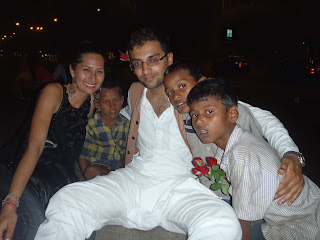
I hated Agra. Outside of the historic buildings, the city is the epitome of all of the awful aspects of India. Merciless rickshaw drivers follow you around for blocks asking if you want a ride somewhere. Hawkers jump in front of you on the sidewalks to try to get you to enter one of their shops. Beggars roam outside the entrances of every tourist attraction. The place is the definition of a "tourist trap": for example, the price of admission to the Taj is 20 rupees for an Indian but 750 rupees for a foreigner. The same goes for all of the important places around the city. And to top it all off, it was monsooning in the morning, and then 110 degrees and humid in the afternoon.

But in spite of all of this, seeing the Taj still makes Agra worth the day trip. The mausoleum is impressive when viewed from rooftops in the Taj Ganj area south of the complex, but from up close it is just enormous. Walking through the archway and looking out over the reflecting pool to catch my first glimpse was pretty stunning.

We spent a couple of hours hanging out at the Taj and then went to Agra Fort. This ancient walled city looks a lot like the Red Fort in Delhi, which was also used as the set for the Bollywood episode I acted in, so it felt like I had already been there.

Over the course of the day, we probably posed for about twenty photos each. Just a rough estimate. This is what I will miss the most about Asia: feeling like a celebrity every time I go to a public place.

An entire page in my Lonely Planet was devoted to arguments about where the best Taj sunset views in Agra are. We settled for a Taj Ganj rooftop. Not bad. Our express train back to Delhi was delayed, so we didn't get back until nearly midnight, then quickly packed and passed out for a few hours before heading to the airport at 5:30 AM. I slept for most of the flight, but vaguely remember being served a GFML with a roll. British Airways needs a lesson in glutenology: your bread is not gluten-free; do not serve it with gluten-free meals. Thanks.

Anyway, I made it to London, parted ways with Matt, and found my friend Naomi patiently waiting for me outside of customs. We made the two hour journey across the city to her apartment, where her brother David joined us and I savored my first gluten-free beer in nearly eight months: a Belgian brand named Green's. It was like drinking my first beer all over again. Mmmm. Naomi also bought me a loaf of gluten-free bread...such a nice welcome back into Westernized society. I'm going to miss Asia, but having beer and bread back in my life will surely fill that void.












































